light YAMAHA XVS1100 2000 Owners Manual
[x] Cancel search | Manufacturer: YAMAHA, Model Year: 2000, Model line: XVS1100, Model: YAMAHA XVS1100 2000Pages: 96, PDF Size: 13.11 MB
Page 15 of 96
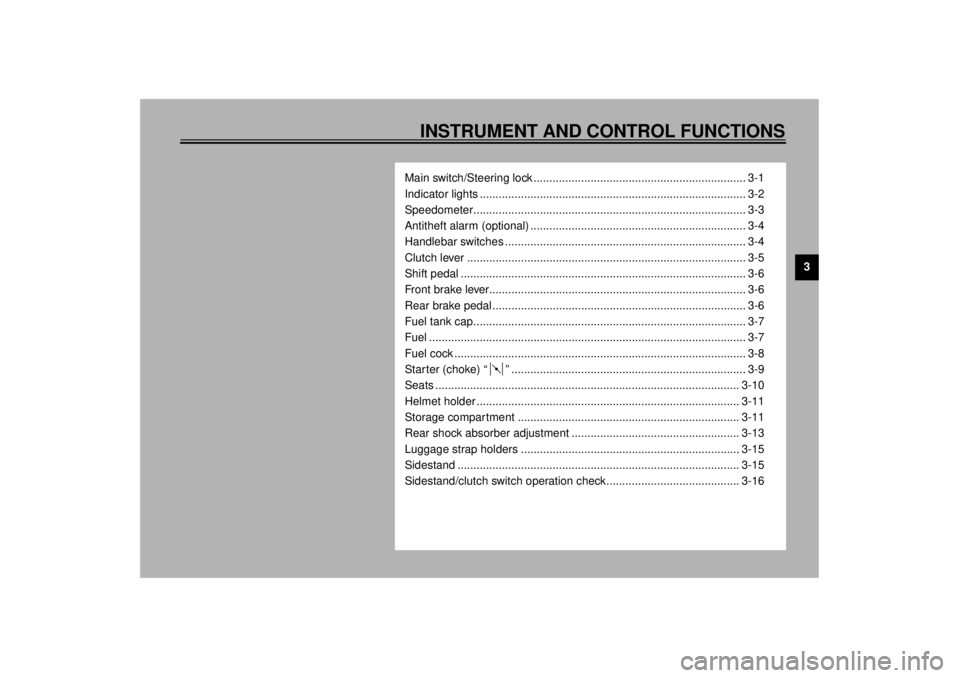
3
INSTRUMENT AND CONTROL FUNCTIONS
Main switch/Steering lock ................................................................... 3-1
Indicator lights .................................................................................... 3-2
Speedometer...................................................................................... 3-3
Antitheft alarm (optional) .................................................................... 3-4
Handlebar switches ............................................................................ 3-4
Clutch lever ........................................................................................ 3-5
Shift pedal .......................................................................................... 3-6
Front brake lever................................................................................. 3-6
Rear brake pedal ................................................................................ 3-6
Fuel tank cap...................................................................................... 3-7
Fuel .................................................................................................... 3-7
Fuel cock ............................................................................................ 3-8
Starter (choke) “ ” .......................................................................... 3-9
Seats ................................................................................................ 3-10
Helmet holder ................................................................................... 3-11
Storage compartment ...................................................................... 3-11
Rear shock absorber adjustment ..................................................... 3-13
Luggage strap holders ..................................................................... 3-15
Sidestand ......................................................................................... 3-15
Sidestand/clutch switch operation check.......................................... 3-16
E_5el_FunctionsTOC.fm Page 1 Monday, May 1, 2000 9:37 AM
Page 16 of 96

3-1
3
EAU00027
3-INSTRUMENT AND CONTROL FUNCTIONS
EAU00029
Main switch/Steering lockThe main switch controls the ignition
and lighting systems. Its operation is
described below.
EAU00036
ON
Electrical circuits are switched on. The
engine can be started. The key cannot
be removed in this position.
EAU00038
OFF
All electrical circuits are switched off.
The key can be removed in this posi-
tion.
EAU00040
LOCK
The steering is locked in this position
and all electrical circuits are switched
off. The key can be removed in this po-
sition. To lock the steering, turn the
handlebars all the way to the left. While
pushing the key into the main switch,
turn it from “OFF” to “LOCK” and re-
move it. To release the lock, turn the
key to “OFF” while pushing.
EW000016
WARNING
@ Never turn the key to “OFF” or
“LOCK” when the motorcycle is
moving. The electrical circuits will
be switched off which may result in
loss of control or an accident. Be
sure the motorcycle is stopped be-
fore turning the key to “OFF” or
“LOCK”. @1. Push
2. Turn
E_5el_Functions.fm Page 1 Monday, May 1, 2000 9:38 AM
Page 17 of 96
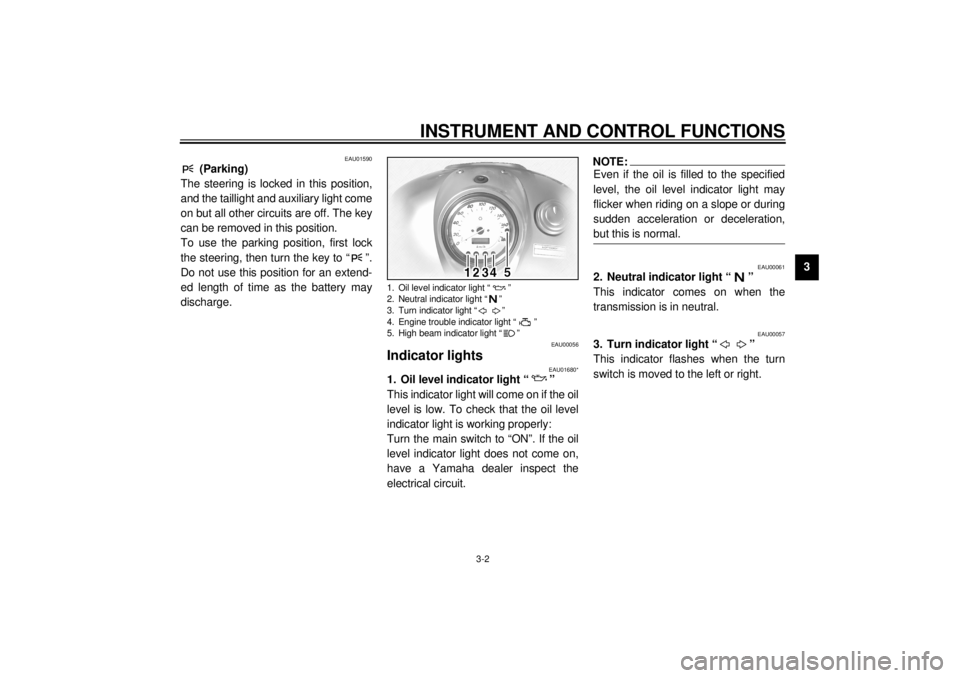
INSTRUMENT AND CONTROL FUNCTIONS
3-2
3
EAU01590
(Parking)
The steering is locked in this position,
and the taillight and auxiliary light come
on but all other circuits are off. The key
can be removed in this position.
To use the parking position, first lock
the steering, then turn the key to “ ”.
Do not use this position for an extend-
ed length of time as the battery may
discharge.
EAU00056
Indicator lights
EAU01680*
1. Oil level indicator light “ ”
This indicator light will come on if the oil
level is low. To check that the oil level
indicator light is working properly:
Turn the main switch to “ON”. If the oil
level indicator light does not come on,
have a Yamaha dealer inspect the
electrical circuit.
NOTE:@ Even if the oil is filled to the specified
level, the oil level indicator light may
flicker when riding on a slope or during
sudden acceleration or deceleration,
but this is normal. @
EAU00061
2. Neutral indicator light “ ”
This indicator comes on when the
transmission is in neutral.
EAU00057
3. Turn indicator light “ ”
This indicator flashes when the turn
switch is moved to the left or right.
1. Oil level indicator light “ ”
2. Neutral indicator light “ ”
3. Turn indicator light “ ”
4. Engine trouble indicator light “ ”
5. High beam indicator light “ ”
E_5el_Functions.fm Page 2 Monday, May 1, 2000 9:38 AM
Page 18 of 96

INSTRUMENT AND CONTROL FUNCTIONS
3-3
3
EAU01672*
4. Engine trouble indicator light
“”
This indicator light will come on or flash
if trouble occurs in a monitoring circuit.
In such a case, take the motorcycle to a
Yamaha dealer to have the self-diag-
nostic systems checked.
To check that the engine trouble indica-
tor light is working properly:
Turn the main switch to “ON”. If the en-
gine trouble indicator light does not
come on, have a Yamaha dealer in-
spect the electrical circuit.
EAU00063
5. High beam indicator light “ ”
This indicator comes on when the
headlight high beam is used.
EAU01202
SpeedometerThis speedometer is equipped with an
odometer and a trip meter. Pushing the
“TRIP” button will change the display
from one to the other. When set to
“ODO”, it indicates the motorcycle’s to-
tal mileage. When set to “TRIP”, it indi-
cates the motorcycle’s mileage since
the trip meter was last reset. Use the
trip meter to estimate how far you can
ride on a tank of fuel. This information
will enable you to plan fuel stops in the
future.To reset the trip meter to “0”, push the
“TRIP” button until it displays “TRIP”,
then push it once again and hold it
down for at least one second.
NOTE:@ This motorcycle does not have a ta-
chometer. However, it is equipped with
an engine speed limiter, which pre-
vents the engine speed from exceed-
ing approximately 6,800 r/min and the
vehicle from exceeding a top riding
speed of approximately 175 km/h. @
1. Trip button
2. Odometer/Trip meter
E_5el_Functions.fm Page 3 Monday, May 1, 2000 9:38 AM
Page 19 of 96

INSTRUMENT AND CONTROL FUNCTIONS
3-4
3
EAU00109
Antitheft alarm (optional)An antitheft alarm can be equipped to
this motorcycle. Consult your Yamaha
dealer to obtain and install the alarm.
EAU00118
Handlebar switches
EAU00119
1. Pass switch “ ”
Press the switch to operate the passing
light.
EAU00121
2. Dimmer switch
Turn the switch to “ ” for the high
beam and to “ ” for the low beam.
EAU00129
3. Horn switch “ ”
Press the switch to sound the horn.
EAU00127
4. Turn signal switch
To signal a right-hand turn, push the
switch to “ ”. To signal a left-hand
turn, push the switch to “ ”. Once the
switch is released it will return to the
center position. To cancel the signal,
push the switch in after it has returned
to the center position.
1. Pass switch “ ”
2. Dimmer switch
3. Horn switch “ ”
4. Turn signal switch
E_5el_Functions.fm Page 4 Monday, May 1, 2000 9:38 AM
Page 20 of 96

INSTRUMENT AND CONTROL FUNCTIONS
3-5
3
EAU00138
1. Engine stop switch
The engine stop switch is a safety de-
vice for use in an emergency such as
when the motorcycle overturns or if
trouble occurs in the throttle system.
Turn the switch to “ ” to start the en-
gine. In case of emergency, turn the
switch to “ ” to stop the engine.
EAU00134
2. Lights switch
Turning the light switch to “ ”,
turns on the auxiliary light, meter lights
and taillight. Turning the light switch to
“ ” turns the headlight on also.
EAU00143
3. Start switch “ ”
The starter motor cranks the engine
when pushing the start switch.
EC000005
CAUTION:@ See starting instructions prior to
starting the engine. @
EAU00152
Clutch leverThe clutch lever is located on the left
handlebar, and the ignition circuit cut-
off system is incorporated in the clutch
lever holder. Pull the clutch lever to the
handlebar to disengage the clutch, and
release the lever to engage the clutch.
The lever should be pulled rapidly and
released slowly for smooth clutch oper-
ation. (Refer to the engine starting pro-
cedures for a description of the ignition
circuit cut-off system.)
1. Engine stop switch
2. Lights switch
3. Start switch “ ”E_5el_Functions.fm Page 5 Monday, May 1, 2000 9:38 AM
Page 35 of 96
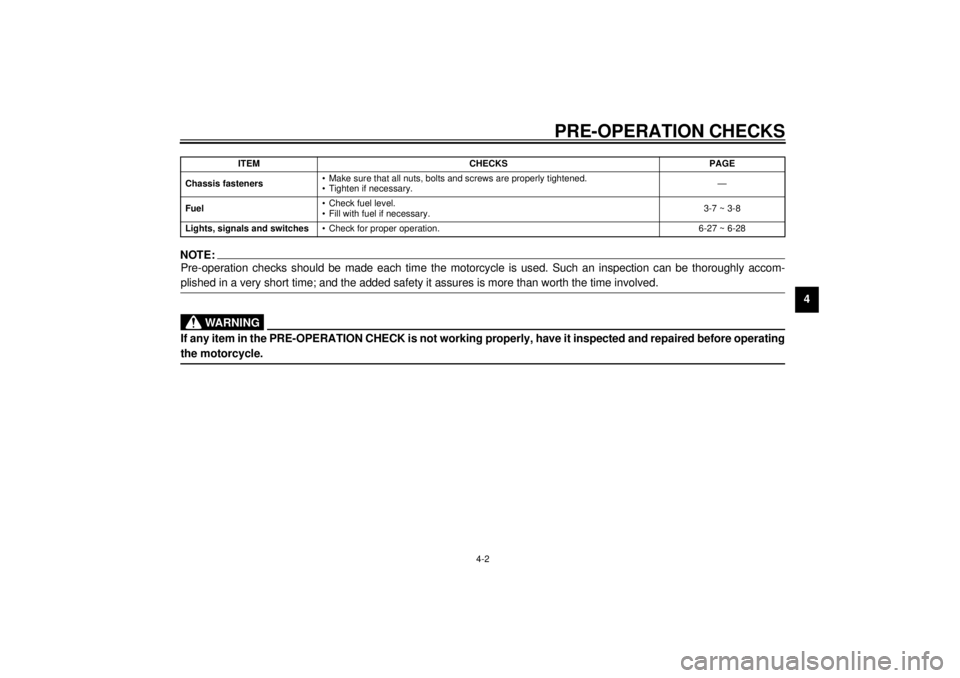
PRE-OPERATION CHECKS
4-2
4
NOTE:Pre-operation checks should be made each time the motorcycle is used. Such an inspection can be thoroughly accom-
plished in a very short time; and the added safety it assures is more than worth the time involved.
WARNING
If any item in the PRE-OPERATION CHECK is not working properly, have it inspected and repaired before operating
the motorcycle.Chassis fasteners• Make sure that all nuts, bolts and screws are properly tightened.
• Tighten if necessary.—
Fuel• Check fuel level.
• Fill with fuel if necessary.3-7 ~ 3-8
Lights, signals and switches• Check for proper operation. 6-27 ~ 6-28 ITEM CHECKS PAGE
E_5el_Preop.fm Page 2 Monday, May 1, 2000 9:39 AM
Page 40 of 96
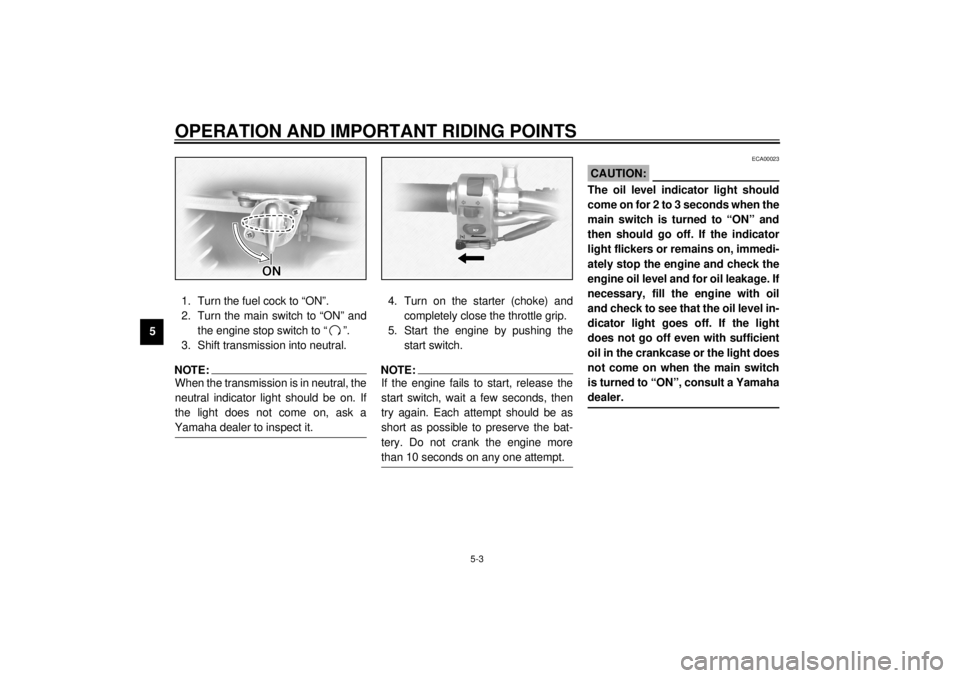
OPERATION AND IMPORTANT RIDING POINTS
5-3
51. Turn the fuel cock to “ON”.
2. Turn the main switch to “ON” and
the engine stop switch to “ ”.
3. Shift transmission into neutral.
NOTE:@ When the transmission is in neutral, the
neutral indicator light should be on. If
the light does not come on, ask a
Yamaha dealer to inspect it. @
4. Turn on the starter (choke) and
completely close the throttle grip.
5. Start the engine by pushing the
start switch.NOTE:@ If the engine fails to start, release the
start switch, wait a few seconds, then
try again. Each attempt should be as
short as possible to preserve the bat-
tery. Do not crank the engine more
than 10 seconds on any one attempt. @
ECA00023
CAUTION:@ The oil level indicator light should
come on for 2 to 3 seconds when the
main switch is turned to “ON” and
then should go off. If the indicator
light flickers or remains on, immedi-
ately stop the engine and check the
engine oil level and for oil leakage. If
necessary, fill the engine with oil
and check to see that the oil level in-
dicator light goes off. If the light
does not go off even with sufficient
oil in the crankcase or the light does
not come on when the main switch
is turned to “ON”, consult a Yamaha
dealer. @
E_5el_Operation.fm Page 3 Monday, May 1, 2000 9:43 AM
Page 42 of 96
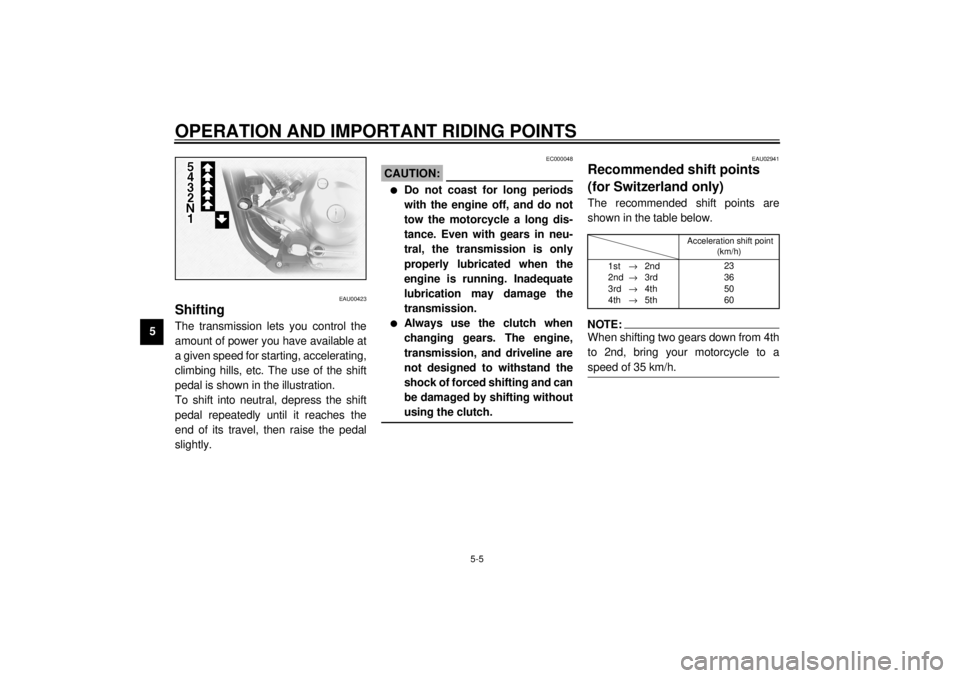
OPERATION AND IMPORTANT RIDING POINTS
5-5
5
EAU00423
ShiftingThe transmission lets you control the
amount of power you have available at
a given speed for starting, accelerating,
climbing hills, etc. The use of the shift
pedal is shown in the illustration.
To shift into neutral, depress the shift
pedal repeatedly until it reaches the
end of its travel, then raise the pedal
slightly.
EC000048
CAUTION:@ l
Do not coast for long periods
with the engine off, and do not
tow the motorcycle a long dis-
tance. Even with gears in neu-
tral, the transmission is only
properly lubricated when the
engine is running. Inadequate
lubrication may damage the
transmission.
l
Always use the clutch when
changing gears. The engine,
transmission, and driveline are
not designed to withstand the
shock of forced shifting and can
be damaged by shifting without
using the clutch.
@
EAU02941
Recommended shift points
(for Switzerland only)The recommended shift points are
shown in the table below.CF-25ENOTE:@ When shifting two gears down from 4th
to 2nd, bring your motorcycle to a
speed of 35 km/h. @
Acceleration shift point
(km/h)
1st®2nd
2nd®3rd
3rd®4th
4th®5th23
36
50
60
E_5el_Operation.fm Page 5 Monday, May 1, 2000 9:43 AM
Page 43 of 96
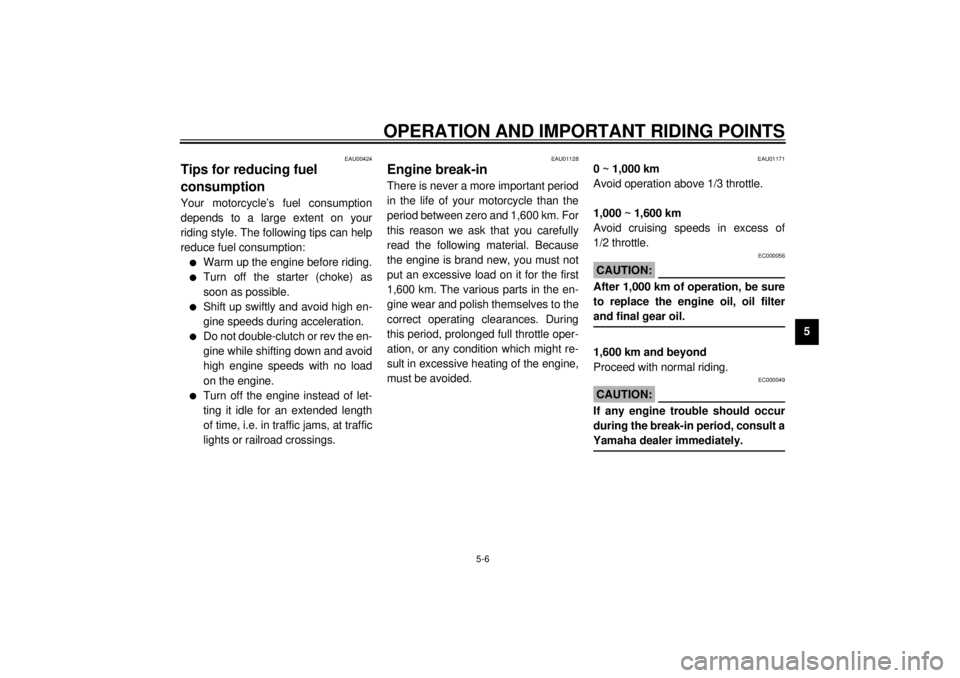
OPERATION AND IMPORTANT RIDING POINTS
5-6
5
EAU00424
Tips for reducing fuel
consumptionYour motorcycle’s fuel consumption
depends to a large extent on your
riding style. The following tips can help
reduce fuel consumption:l
Warm up the engine before riding.
l
Turn off the starter (choke) as
soon as possible.
l
Shift up swiftly and avoid high en-
gine speeds during acceleration.
l
Do not double-clutch or rev the en-
gine while shifting down and avoid
high engine speeds with no load
on the engine.
l
Turn off the engine instead of let-
ting it idle for an extended length
of time, i.e. in traffic jams, at traffic
lights or railroad crossings.
EAU01128
Engine break-inThere is never a more important period
in the life of your motorcycle than the
period between zero and 1,600 km. For
this reason we ask that you carefully
read the following material. Because
the engine is brand new, you must not
put an excessive load on it for the first
1,600 km. The various parts in the en-
gine wear and polish themselves to the
correct operating clearances. During
this period, prolonged full throttle oper-
ation, or any condition which might re-
sult in excessive heating of the engine,
must be avoided.
EAU01171
0 ~ 1,000 km
Avoid operation above 1/3 throttle.
1,000 ~ 1,600 km
Avoid cruising speeds in excess of
1/2 throttle.
EC000056
CAUTION:@ After 1,000 km of operation, be sure
to replace the engine oil, oil filter
and final gear oil. @1,600 km and beyond
Proceed with normal riding.
EC000049
CAUTION:@ If any engine trouble should occur
during the break-in period, consult a
Yamaha dealer immediately. @
E_5el_Operation.fm Page 6 Monday, May 1, 2000 9:43 AM